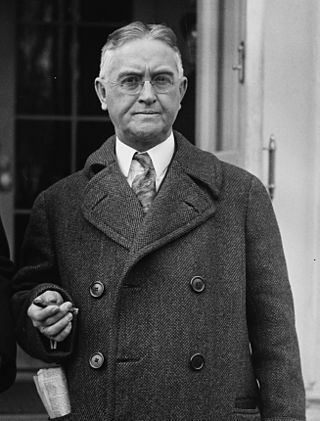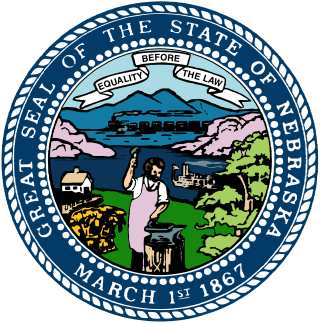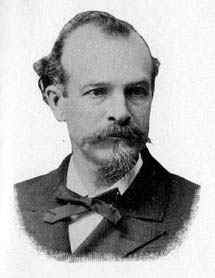
The 2006 Alabama gubernatorial election occurred on November 7, 2006. Incumbent Republican Governor Bob Riley defeated Democratic Lieutenant Governor Lucy Baxley. Riley garnered 21% of African Americans' votes.

United States gubernatorial elections were held on November 5, 2002, in 36 states and two territories. The Republicans won eight seats previously held by the Democrats, as well as the seat previously held by Minnesota governor Jesse Ventura, who was elected on the Reform Party ticket but had since renounced his party affiliation. The Democrats won 10 seats previously held by the Republicans, as well as the seat previously held by Maine governor Angus King, an independent. The elections were held concurrently with the other United States elections of 2002.

The 1896 South Dakota gubernatorial election was held on November 3, 1896. Incumbent Republican Governor Charles H. Sheldon declined to run for re-election to a third term. Former Secretary of State Amund O. Ringsrud was nominated as Sheldon's replacement at the Republican convention. Ringrud's main opponent was businessman Andrew E. Lee, who was nominated by a makeshift coalition of Populists, Free Silver Republicans, and Democrats. In the general election, Lee narrowly defeated Ringsrud, the first defeat for the Republican Party in a gubernatorial election since statehood.

The 1898 South Dakota gubernatorial election was held on November 8, 1898. Incumbent governor Andrew E. Lee, elected in 1896 as a Populist, he ran for re-election as a Fusion candidate. He was challenged by Republican nominee Kirk G. Phillips, the state treasurer. Lee narrowly defeated Phillips to win his second term as governor, but most of his Fusion allies lost their elections, leaving him as the lone statewide officeholder.

United States gubernatorial elections were held on November 3, 2020, in 11 states and two territories. The previous gubernatorial elections for this group of states took place in 2016, except in New Hampshire and Vermont where governors only serve two-year terms. These two states elected their current governors in 2018. Nine state governors ran for reelection and all nine won, while Democrat Steve Bullock of Montana could not run again due to term limits and Republican Gary Herbert of Utah decided to retire at the end of his term.

The 2020 Indiana gubernatorial election was won by incumbent Republican Eric Holcomb on November 3, 2020. The election was held concurrently with the 2020 U.S. presidential election, as well as elections to the United States House of Representatives and various state and local elections.

The 1924 Nebraska gubernatorial election was held on November 4, 1924, and featured former state Senator Adam McMullen, a Republican, defeating Democratic nominee, former state Representative John N. Norton, and Progressive nominee, Omaha City Commissioner Dan B. Butler.

The 1902 Michigan gubernatorial election was held on November 4, 1902. Incumbent Republican Aaron T. Bliss defeated Democratic candidate Lorenzo T. Durand with 52.52% of the vote.

The 1900 Washington gubernatorial election was held on November 6, 1900.

The 1910 Nebraska gubernatorial election was held on November 8, 1910.

The 1900 Nebraska gubernatorial election was held on November 6, 1900.

The 1898 Nebraska gubernatorial election was held on November 8, 1898. Incumbent Populist Governor Silas A. Holcomb did not stand for re-election. Populist and Democratic fusion nominee William A. Poynter defeated Republican nominee Monroe Hayward with 50.19% of the vote.

The 1888 Nebraska gubernatorial election was held on November 6, 1888, and featured incumbent Governor John Milton Thayer, a Republican, defeating Democratic nominee John A. McShane, Prohibition nominee George E. Bigelow, and the Union Labor nominee, former impeached Nebraska Governor David Butler, to win a second two-year term in office.

The 1894 Nebraska gubernatorial election was held on November 6, 1894. Incumbent Republican Governor Lorenzo Crounse did not stand for re-election. Populist and Democratic fusion nominee Silas A. Holcomb defeated the Republican nominee, incumbent Lieutenant Governor of Nebraska Thomas Jefferson Majors.

The 1878 Nebraska gubernatorial election was held on November 5, 1878. Incumbent Republican governor Silas Garber did not seek reelection. This election featured Republican nominee Albinus Nance, the Speaker of the Nebraska House of Representatives, defeating Democratic nominee Colonel William H. Webster, a lawyer from Merrick County, Nebraska, and Greenback Party nominee Levi G. Todd, a former member of the Nebraska Territorial House of Representatives from Cass County, Nebraska.

The 1876 Nebraska gubernatorial election was held on November 7, 1876. It was the first election held under the newly adopted Nebraska Constitution of 1875. The election featured incumbent Governor Silas Garber, a Republican, defeating Democratic nominee Paren England, a lawyer from Lancaster County, Nebraska, and Greenback Party nominee Jonathan F. Gardner, former independent candidate for Governor of Nebraska in 1874.

The 1894 Nebraska lieutenant gubernatorial election was held on November 6, 1894, and featured Republican nominee Robert E. Moore defeating Populist and Democratic fusion nominee James N. Gaffin as well as Straight Democratic (anti-Populist) nominee Rodney E. Dunphy and Prohibition Party nominee Belle G. Bigelow.

The 1896 Nebraska lieutenant gubernatorial election was held on November 3, 1896, and featured Populist and Democratic fusion nominee James E. Harris defeating his major rival, Republican nominee Orlando Tefft. Other candidates who received two percent of the vote or less included Gold Democratic nominee Owen F. Biglin, Prohibition nominee Lucius O. Jones, Socialist Labor nominee Fred Herman, and National Silver nominee Oscar Kent. Incumbent Nebraska Lieutenant Governor Robert E. Moore did not seek reelection.

The 1898 Nebraska lieutenant gubernatorial election was held on November 8, 1898, and featured Populist and Democratic fusion nominee Edward A. Gilbert defeating Republican nominee George A. Murphy as well as Prohibition nominee Newell S. Lowrie and Socialist Labor nominee J. J. Kerrigan.

The 1900 Nebraska lieutenant gubernatorial election was held on November 6, 1900, and featured Republican nominee Ezra P. Savage defeating incumbent Nebraska Lieutenant Governor Edward A. Gilbert, the Populist and Democratic fusion nominee. Other candidates who received two percent of the vote or less included Prohibition nominee Charles R. Lawson, Midroad Populist nominee Herman G. Reiter, and Social Democratic nominee David McKibben.


















